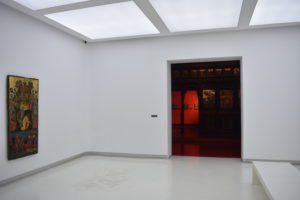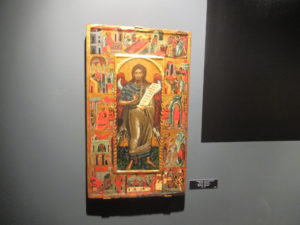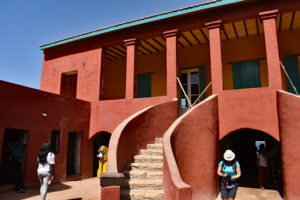During our three days in Korça, south east Albania, we were constantly asked ‘have you been to the National Museum of Medieval Art yet?’ So, we thought it must be something special, although, as we eventually discovered, our Bradt guide didn’t do it justice.
The museum can appear closed unless you spot the bell at the side of the large wooden door, which is kept shut for humidity reasons.
We were given a brief verbal introduction to the museum by the curator who told us that, when the communists banned religion in 1967, a few intellectuals began collecting and storing icons from Orthodox churches to prevent them from being destroyed or defaced. The museum opened in 1982, still in the communist period, which seemed a little odd. The collection has over 9,000 icons from all over Albania (although not all are on display), and the location of Korça, was chosen, rather than the capital Tirana, as many artists were from the region. Although there were signs saying ‘no photographs’, we were told that as it was quiet (we were the only visitors at 9am), we could take a couple of non-flash pictures in each room.
The German architect wanted to create a ‘wow factor’ at the entrance which he certainly did. The aptly named Golden Wall, covered two floors and its 9.5 metre height was adorned from floor to ceiling with icons of varying sizes, many featuring Mary and Jesus together, Jesus and John the Baptist. The majority were by the most well-known artists, which included Onufri, noted for his use of the colour red, created by using quicksilver or mercury. Some of the faces in the icons, would have been based on real people. They were not arranged in any chronological order, but we were shown how to identify those from the Ottoman period when Christ was shown wearing a crown and floral robes, seated on pillows.
As well as icons, there were painted ‘Royal Doors’ which only priests can pass through: together these form the iconostasis or wall of religious paintings which separate the nave from the sanctuary. From the stairs we had a better view of the icons higher up on the walls.
None of the Golden Wall icons were labelled, although there was a line chart which we found a little confusing. However, the exhibits in subsequent rooms were clearly labelled in English with the subject, painter, date, church, and location of origin.
A room with dark walls and a creaky floor, led us to the Red Room with its red floor, walls and ceiling. It was here we found the portrait of St Christopher with a ‘dog head’ which apparently came about because of a Byzantine mistranslation of the word ‘Canaanite’. In Latin, it translates to ‘Cananeus’, which was remarkably similar to the word for dog or canine: ‘canineus’. Down the centre was a huge wooden 18th century iconostasis and many works by Konstantinos of Shpat.
The light and bright White Room simply had two sets of Royal Doors and it took our eyes a little time to adjust on entering the final room, the Black Labyrinth Pavilion with yet more icons by Onufri, where the bright red colours really radiated on the black walls.
Stairs took us down (there is a lift) where there were displays of other religious items in glass cases, but not as many as suggested in Bradt. Just as we reached the bottom steps, a large group of noisy Germans arrived, and we were pleased we’d had the place to ourselves.
The entrance fee is 700 Lek/£5.20 per person, which is more than most sights in Albania, but it’s worth every penny.










